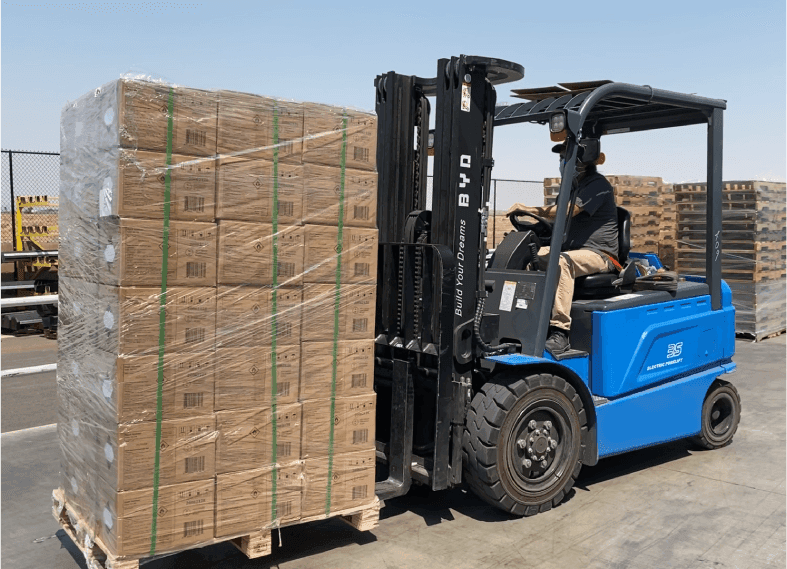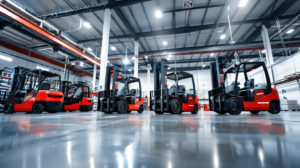1. Introduction
The industrial equipment sector is undergoing a profound transformation, with China emerging as a global leader in electric forklift manufacturing. This innovation represents a crucial shift towards sustainability and efficiency, reflecting broader global trends. Forklifts, the backbone of warehousing and logistics, have traditionally relied on diesel or LPG. However, electric forklifts have gained traction due to their environmental benefits, reduced operational costs, and technological sophistication. This article explores the factors driving China’s electric forklift industry and its implications for the global economy.

2. Overview of the Electric Forklift Industry
2.1 The Global Landscape
Electric forklifts are redefining the material handling industry. Globally, the demand for electric forklifts has surged, outpacing traditional models. This growth is fueled by stricter emission regulations, advancements in battery technology, and the increasing need for efficient warehouse operations.
2.2 China’s Rapid Growth in the Sector
China has quickly become the largest manufacturer and exporter of electric forklifts. The country has invested heavily in research and development (R&D) and advanced manufacturing processes, leveraging its competitive edge in battery production and robotics.
3. Key Drivers Behind China’s Electric Forklift Boom
3.1 Government Policies and Incentives
The Chinese government has implemented favorable policies to promote green technologies. Subsidies for electric vehicle (EV) manufacturers extend to industrial equipment, incentivizing the production of electric forklifts. Furthermore, regulations limiting emissions in urban areas have increased demand for clean alternatives.
3.2 Technological Advancements
China’s expertise in lithium-ion battery production has given its forklift industry a significant boost. Innovations such as fast-charging systems and longer battery lifespans have made electric forklifts more reliable and cost-effective, appealing to a global audience.
4. Economic Impacts of the Industry
4.1 Boost to Local Manufacturing
The electric forklift industry has created thousands of jobs in China, revitalizing local economies. Small and medium-sized enterprises (SMEs) in the supply chain also benefit from the sector’s growth.
4.2 Export Opportunities and Global Influence
China exports electric forklifts to markets worldwide, particularly in Asia, Europe, and Africa. These exports strengthen China’s position as a leader in sustainable technology and contribute to its global economic influence.

5. Environmental Benefits of Electric Forklifts
5.1 Reduction in Carbon Emissions
Switching from gas-powered forklifts to electric models significantly reduces greenhouse gas emissions. This shift aligns with China’s broader goals to achieve carbon neutrality by 2060.
5.2 Contribution to Circular Economy Goals
Electric forklifts are designed with recyclable materials and components, supporting circular economy principles. End-of-life batteries, for example, are repurposed or recycled, minimizing waste.
6. Technological Innovations in China’s Electric Forklifts
6.1 Battery Advancements
China’s leadership in lithium-ion technology has enabled breakthroughs in forklift battery performance. These batteries are now lighter, more efficient, and capable of operating for extended hours.
6.2 Integration of IoT and AI
Smart forklifts equipped with IoT sensors and AI algorithms optimize operations by tracking performance, diagnosing issues, and reducing downtime. These advancements improve productivity and safety.
7. Challenges Facing the Industry
7.1 Infrastructure Limitations
Despite rapid growth, charging infrastructure remains a challenge. Expanding the availability of charging stations is essential for sustaining the industry’s momentum.
7.2 Competition from Global Brands
Chinese manufacturers face stiff competition from established global players like Toyota and Hyster-Yale. Differentiating through innovation and quality remains a priority.

8. Role of Local and International Players
8.1 Leading Chinese Manufacturers
Companies like BYD, Heli, and Hangcha have dominated the domestic and international markets, setting benchmarks for affordability and efficiency.
8.2 Collaboration with Foreign Companies
Partnerships with global firms have allowed Chinese companies to access advanced technologies and expand their reach.
9. The Impact on Supply Chain and Logistics
9.1 Efficiency Gains in Warehousing
Electric forklifts enhance operational efficiency by reducing downtime and maintenance costs. Their quiet operation also improves working conditions in warehouses.
9.2 Case of Sustainable Supply Chains
The adoption of electric forklifts reduces the environmental footprint of supply chains, making them more sustainable and attractive to ESG-conscious stakeholders.
10. Future of Autonomous Electric Forklifts
10.1 Current Developments
Autonomous forklifts are an emerging trend, combining AI and electric propulsion. These machines are capable of navigating complex environments without human intervention.
10.2 Potential Market Expansion
The autonomous forklift market is poised for significant growth, driven by industries seeking to automate repetitive tasks and enhance safety.

11. Social and Workforce Impacts
11.1 Changes in Employment Dynamics
The transition to electric forklifts has altered workforce demands, emphasizing technical skills and maintenance expertise.
11.2 Skill Development Initiatives
Chinese manufacturers have launched training programs to upskill workers, ensuring a smooth transition to new technologies.
12. Comparing China’s Electric Forklifts to Gas-Powered Models
12.1 Cost Efficiency
Electric forklifts offer long-term savings through reduced fuel and maintenance costs, offsetting their higher upfront price.
12.2 Performance Metrics
Modern electric forklifts match or exceed the performance of gas-powered models, providing comparable lift capacity and reliability.
13. Global Adoption of Chinese Electric Forklifts
13.1 Growing Demand in Emerging Markets
Affordable and efficient, Chinese electric forklifts are gaining traction in emerging markets where cost considerations are critical.
13.2 Strategic Partnerships
Collaborations with local distributors and service providers have facilitated the global adoption of Chinese forklifts.

14. Sustainability as a Competitive Advantage
14.1 Alignment with Global ESG Goals
Electric forklifts support corporate ESG initiatives, offering businesses a tangible way to reduce emissions and meet sustainability targets.
14.2 Long-Term Implications for Industry Leaders
Adopting sustainable practices not only benefits the environment but also enhances brand reputation and customer loyalty.
15. Conclusion: A Transformative Path Forward
China’s electric forklift industry exemplifies the power of innovation and commitment to sustainability. By investing in cutting-edge technology and fostering an ecosystem of green manufacturing, China is reshaping the logistics and material handling sectors. As the global demand for clean and efficient industrial equipment grows, China’s electric forklifts are well-positioned to lead the charge, offering a glimpse into the future of sustainable industry.





